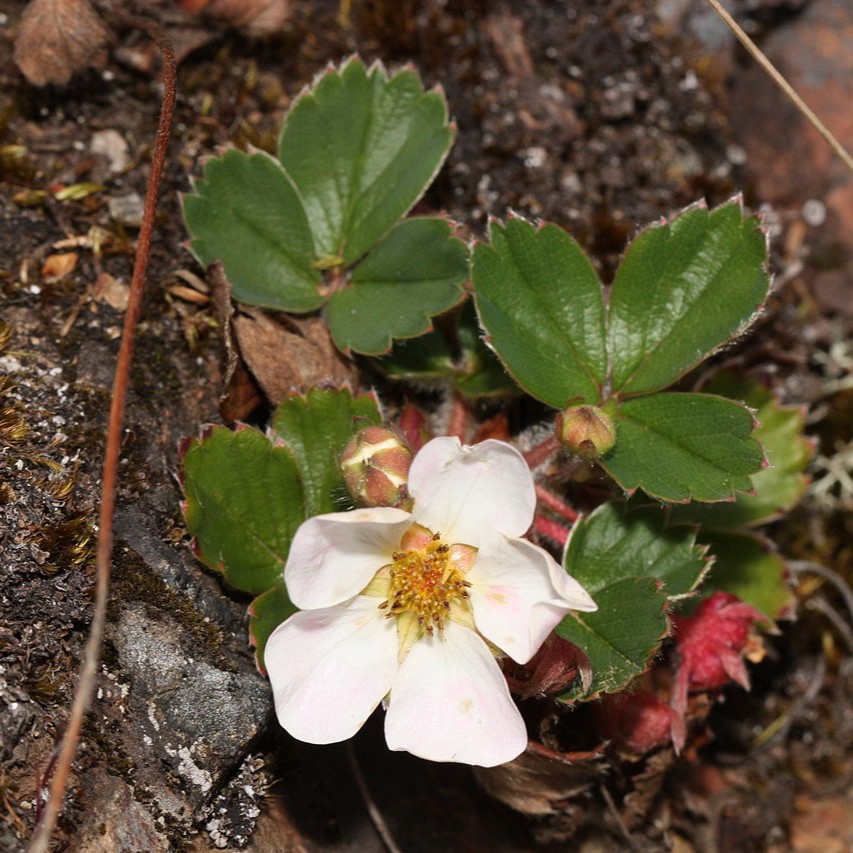Fragaria virginiana
Overview
| Genus | Fragaria |
| Species | virginiana |
| Common Name | Virginia strawberry, wild strawberry, common strawberry, or mountain strawberry |
| Abbreviation | F. virginiana |
| Ploidy | Octoploid |
| Chromosome Number | 8n=8x=56 |
| Genome Size | 780 Mb |
| Genome Assemblies | 1 |
| Cross Reference | NCBI taxon: 101015 |
Organism Image

Description
Fragaria virginiana, known as Virginia strawberry, wild strawberry, common strawberry, or mountain strawberry, is a North American strawberry that grows across much of the United States and southern Canada. It is one of the two species of wild strawberry that were hybridized to create the modern domesticated garden strawberry (Fragaria × ananassa).
All strawberries have a base haploid count of 7 chromosomes. Fragaria virginiana is octoploid, having eight sets of these chromosomes for a total of 56. These eight genomes pair as four distinct sets, of two different types, with little or no pairing between sets. The genome composition of the octoploid strawberry species has generally been indicated as AAA'A'BBB'B'. The A-type genomes were likely contributed by diploid ancestors related to Fragaria vesca or similar species, while the B-type genomes seem to descend from a close relative of Fragaria iinumae. The exact process of hybridization and speciation which resulted in the octoploid species is still unknown, but it appears that the genome compositions of both Fragaria chiloensis and Fragaria virginiana (and by extension their hybrid, the cultivated octoploid garden strawberry as well) are identical.
Fragaria virginiana can grow up to 100 mm (4 in) tall. The plant typically bears numerous trifoliate leaves that are green on top, pale green on the lower surface. Each leaflet is about 75 mm (3 in) long and 40 mm (1+1⁄2 in) wide. The leaflet is oval shaped and has coarse teeth along the edge except near the bottom. This plant has a five-petaled white flower with numerous pistils, surrounded by yellow-anthered stamens. There are ten small green sepals under the petals. The seeds of this plant are developed from the pistils in the centre of the flower which will become dark-coloured fruit (achenes) on the strawberry. The fruit of the wild strawberry is smaller than that of the garden strawberry (Fragaria × ananassa). Botanically, the fruit is classified as an aggregate accessory fruit, but it is commonly called a berry. Strawberries reproduce both sexually by seed, and asexually by runners (stolons).Fragaria virginiana can grow up to 100 mm (4 in) tall. The plant typically bears numerous trifoliate leaves that are green on top, pale green on the lower surface. Each leaflet is about 75 mm (3 in) long and 40 mm (1+1⁄2 in) wide. The leaflet is oval shaped and has coarse teeth along the edge except near the bottom. This plant has a five-petaled white flower with numerous pistils, surrounded by yellow-anthered stamens. There are ten small green sepals under the petals. The seeds of this plant are developed from the pistils in the centre of the flower which will become dark-coloured fruit (achenes) on the strawberry. The fruit of the wild strawberry is smaller than that of the garden strawberry (Fragaria × ananassa). Botanically, the fruit is classified as an aggregate accessory fruit, but it is commonly called a berry. Strawberries reproduce both sexually by seed, and asexually by runners (stolons).
Whole Genomes
Whole Genome Sequences & Annotations for Fragaria virginiana
S genes
Fragaria S genes Nucleotide
- Fragaria viridis cultivar 42 Sa-RNase mRNA, complete cds
- Fragaria viridis cultivar 42 Sb-RNase mRNA, complete cds
- Fragaria nipponica S-RNase mRNA, complete cds
Fragaria S genes Protein
Downloads
The Fragaria S gene sequences are available in FASTA format.
| CDS and Protein (FASTA file) | S-gene_Fragaria |
Publications
Jin X, Du H, Zhu C, Wan H, Liu F, Ruan J, Mower JP, Zhu A. Haplotype-resolved genomes of wild octoploid progenitors illuminate genomic diversifications from wild relatives to cultivated strawberry. Nat Plants. 2023 Aug;9(8):1252-1266. doi: 10.1038/s41477-023-01473-2.